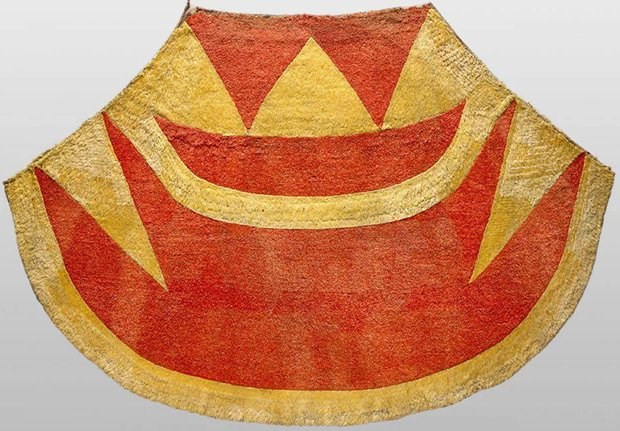IntroductionHave you ever stopped to notice the birds? Birds are an important part of our ecosystem. They help disperse native plant seeds and pollinate flowers that allow for healthy native vegetation to grow. Every bird has an interesting story to tell that shows why they are magnificent. Exhibited are endemic birds to Hawai‘i that you can find here at Haleakalā. While you are reading about the birds of Haleakalā think about the species in your own neighborhood and what interesting stories they might have to tell.
Cultural SignificanceNative Hawaiian birds are significant to the Native Hawaiian culture. Birds are depicted in Hawaiian mo‘olelo (stories), they are seen as ʻaumakua (guardian spirits), and their feathers are used for adornment. One of these birds is the ‘apapane or Hawaiian honeycreeper. Its crimson feathers were prized by Hawaiian nobility and used to make ‘ahu ‘ula (feather capes), mahiole (helmets), kāhili (feather standard), and nā lei hulu (feather lei).

AdaptationThe Hawaiian Islands are home to a large biodiversity of insects, plants, and birds. One of the most adaptive bird species is the Hawaiian honeycreeper. Adaptive radiation has allowed for the honeycreeper to diversify rapidly from an ancestral species that arrived in Hawai‘i 15 to 20 million years ago. Adaptive radiation happens when a species comes into a new environment, with new resources and challenges. Because the Hawaiian Islands are isolated, the Honeycreeper was able to evolve into an array of species with different physical traits. At one point, there were more than 50 known species that lived in Hawai‘i. Today there are only 17 species remaining. Exhibited is an ‘amakihi that is one of the most common and adaptable of the Hawaiian honeycreepers. The ‘amakihi has evolved its tongue to be tubular, which allows for it to drink nectar from flowers like the ‘ōhi‘a lehua, ʻākala (Rubus hawaiensis), and māmane (Sophora chrysophylla). Because the ‘amakihi is able to adapt it is less affected by habitat loss and avian malaria which is affecting other native bird populations. 
ArrivalThe Hawaiian Islands are only around 5 million years old and were created by volcanic activity. They are also surrounded by over 2,000 miles of water. So how did birds get here? Well one of the birds that we have at Haleakalā has a long and interesting history of how it arrived and evolved in this place. The nēnē (Hawaiian Goose) exhibited is the only living endemic goose to the Hawaiian Islands and is the state bird! This goose is closely related to the Canada goose (Branta canadensis) and is the only species of goose found on islands. It is believed that the nēnē’s ancestors evolved from a Canada goose that took a wrong turn during migration about half a million years ago and ended here up here on the Hawaiian Islands. Since arriving here they have adapted to the volcanic landscape and have become their own species.Sadly, by 1952 the population of the nēnē had dropped to 30 birds in the Hawaiian Islands. With the help of a nēnē breeding program, Haleakalā was able to introduce 500 birds in the 1960s. To help re-introduce the birds, the Boy Scouts helped carry them into the wilderness (see photo). Today, the park has an estimate of 280 birds and a statewide population of 3,159. 
NPS photo 
NavigationLike the ancient Hawaiians who were excellent navigators, birds are too. Haleakalā is home to the largest nesting colony of ‘ua‘u (Hawaiian Petrel) in Hawai‘i. Scientists believe that ‘ua‘u use the stars to navigate when they are out at sea hunting for fish and squid. They nest in the steep slopes of Haleakalā in burrows and are only there from February through November. The rest of the year – including right now - they are out at sea!If you visit the park between February and November, you likely won't see the ʻuaʻu because they generally fly in after dark and leave before dawn, but you might hear them. Our ʻuaʻu are named for the eerie call they make (oo-ah-oo) when they fly at night. ‘Ua‘u are the only endangered seabird in Hawai‘i and there are approximately 8,000-10,000 birds living within Haleakalā National Park. 
DisappearanceHawai‘i is losing its native bird population. Their habitat is threatened by the disruption to their natural ecosystems. Habitat loss, climate change, and the impacts of introduced mammals – like cats and mongooses - are the major reasons for decline of these creatures. Avian malaria and poor hatching success are also responsible for population decline. The images exhibited are just a few of the birds that Haleakalā is trying to protect and are federally listed by the U.S. Fish & Wildlife Service. These birds are all endemic to Maui. The critically endangered Maui nukupuʻu, was last sighted in 1989. The critically endangered ʻākohekohe (crested honeycreeper) is the largest in size of the honeycreepers remaining on Maui. The critically endangered kiwikiu (Maui parrotbill) presently only has a population of around 160, and is currently the target of a multi-agency captive breeding and relocation program.ConservationNational Park Service (NPS) conservation efforts have been ongoing to protect these endemic birds. The NPS has fenced the park to exclude invasive animals such as goats and pigs that are harmful to the native ecosystem. The NPS monitors and maintains the fence today. Park staff restore native habitat by removing invasive plants and planting native ones. This in turn helps to establish more native habitat for these endangered birds. The Park has been working with other organizations on methods to understand and combat the factors causing the decline of native bird populations. |
Last updated: December 9, 2019
